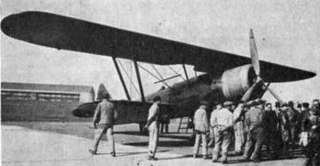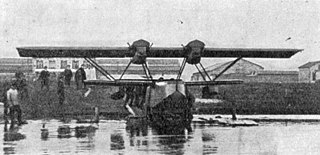
The Latécoère 350 was a trimotor development of the Latécoère 28, a successful single-engined French monoplane of around 1930. The three engines were intended to provide the reliability needed for overnight flights, but the 350 came out very overweight. Only one was built.
The Couzinet 10 Arc-en-Ciel ('Rainbow') was built as a first example of the three-engined, aerodynamically refined, cantilever low wing monoplane designer René Couzinet thought offered the safest long range passenger transport, for example on the South Atlantic route. Only one was completed, though other, similar aircraft of different sizes and powers followed.

The Potez-CAMS 160 was a one-off 5/13 scale flight model built in France, first flown in the summer of 1938 to test aerodynamic and hydrodynamic qualities of the Potez-CAMS 161 airliner and mail carrier, which was too large for detailed modelling in existing wind tunnels.

The Potez 31 was a prototype French two-seat night fighter, flown in about 1928, intended to fill the Cn.2 specification for the Armee de l'Air. Only one was built.
The Caudron C.99 was a French light bomber and reconnaissance aircraft. The only example flew with different engines in the mid-1920s.

The Les Mureaux 3 C.2 and Les Mureaux 4 C.2 were French two seat, parasol winged fighters, flown in 1927-8, which differed only in their engines. They were developed into near identical army co-operation types, the ANF Les Mureaux 130 A.2 and ANF Les Mureaux 131 A.2, in 1929-31.

The Aviméta 88 was an all-metal French two-seat reconnaissance-fighter or heavy fighter tested in 1927.

The Amiot 110-S was an all-metal, amphibious military flying boat built in France in the 1930s. It was intended as a maritime reconnaissance and medium bomber aircraft but only two were built.

The Lioré et Olivier H-23-2 was an amphibious maritime reconnaissance flying boat, built in France in 1932. Three were produced for the Venezuelan Army Air Service.

The four-engined Lioré et Olivier LeO H-27 was one of three French flying boats competing to carry mail over Air France's South Atlantic routes. Flying later than its competitors, it was not selected and only one was built.
The Bloch MB.141 was a French all-metal two seat light aircraft derived from the Bloch MB.81 air ambulance. Only one was built.

The Potez 50 or Potez 50 A2 was a French two seat military multi-rôle aircraft, first flown in 1931. It did not go into service but seven variants using five different engines were produced, one of them setting several speed with useful load records and another, the Potez 506, setting three altitude world records.

The CAMS 110 was a French twin engine biplane flying boat built to fill a range of maritime military rôles including long range reconnaissance, bombing and general exploration. it was not selected for production and only one was built.

The Wibault 260 R.2 was a contender for a French government contract for a long range, two seat reconnaissance aircraft, issued in 1928. There were eight prototypes in the 1931-2 contest and the Wibault was not selected for production.

The CAMS 52 was a twin-engined floatplane torpedo-bomber. It was not ordered by the French Navy and only one CAMS 52 was completed. It first flew in the summer of 1930.

The CAMS 80 was an amphibious reconnaissance flying boat flown in the early 1930s. Two were built with different engines and were used by the Aéronavale for VIP transport and equipment development until 1938.

The Dornier Do S was a large, 22-passenger flying boat airliner flown in Germany in 1930. Only one was built.

The Lioré et Olivier LeO H-23 was a French military flying boat, primarily intended for coastal reconnaissance, though able to carry a small bomb load. Only one was built.
The CPA 1 was a French twin-engined, parasol-winged bomber designed and built in the mid-1920s.

The Hanriot H.38 was a French twin-engined sesquiplane flying boat built in the mid-1920s. Though the sole prototype was fitted with two defensive machine gun posts. the H.38 was described at the time as a utility aircraft.

















